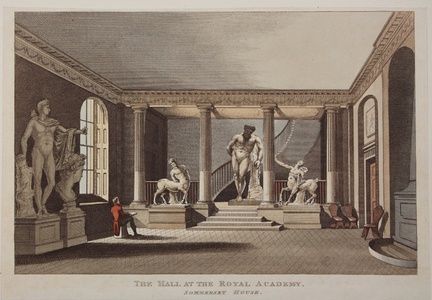| Method | Copper engraving with hand colouring |
| Artist | [Anonymous] |
| Published | [No. 3. of Ackermann's Repository of Arts &c. Pub. 1 May 1810 at 101 Strand London.] |
| Dimensions | Image 112 x 173 mm, Sheet 127 x 183 mm |
| Notes |
Plate 29 from Issue No. 3 of 'Ackermann's Repository of Arts, Literature, Commerce, Manufactures, Fashions, and Politics'. The print depicts the plaster casts of the famous sculptures of the Apollo Belvedere, the Farnese Hercules and the Furietti Centaurs, set in the entrance hall of Somerset House, when home to the Royal Academy in 1810. Rudolph Ackermann (1764 - 1834) was a lithographer and publisher born in Saxony. He moved to London in 1787 and later established a business as a coachmaker at 7 Little Russell Street, Covent Garden. In 1796, having already published the first of many books of carriage designs, he moved to 96 Strand where he ran a drawing school for ten years. The following year, Ackermann moved to 101 Strand (known, from 1798, as The Repository of Arts) where he sold old master paintings and artists' supplies as well as prints. In 1803, 220 Strand was given as his address in a print published that year. The Microcosm of London (1808-10) and the monthly Repository of Arts (1809-29) established his reputation for fine colour plate books. From 1816, he began to publish lithographs. Ackermann always maintained links with his native Germany, and in the 1820s, he also opened outlets in Mexico, Guatemala, Colombia, Argentina, and Peru. In 1832, he handed the running of the business over to his second son George and his younger brothers, who traded as Ackermann & Co.at 106 The Strand until 1861. Ackermann also established a print business for his eldest son Rudolph at 191 Regent Street. Condition: Trimmed within platemark and grangerised |
| Framing | unmounted |
| Price | £50.00 |
| Stock ID | 48788 |

